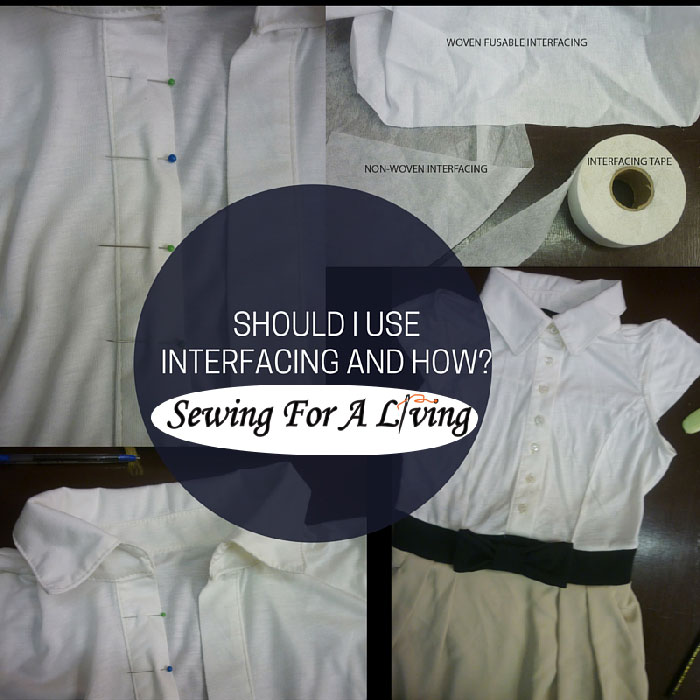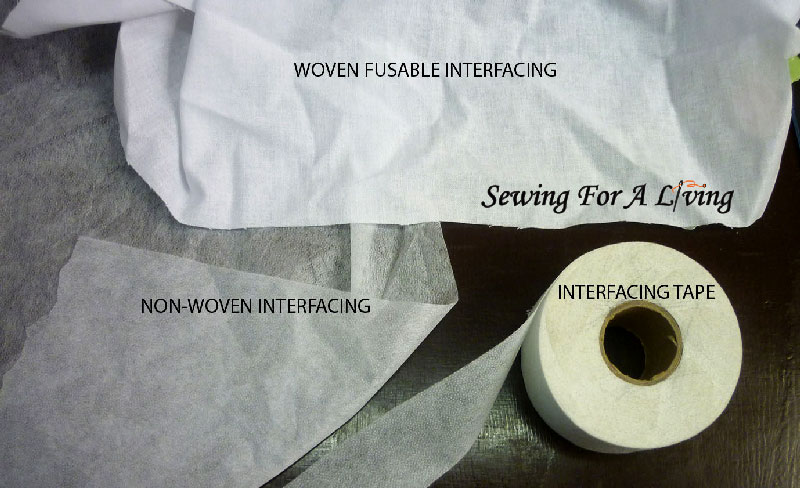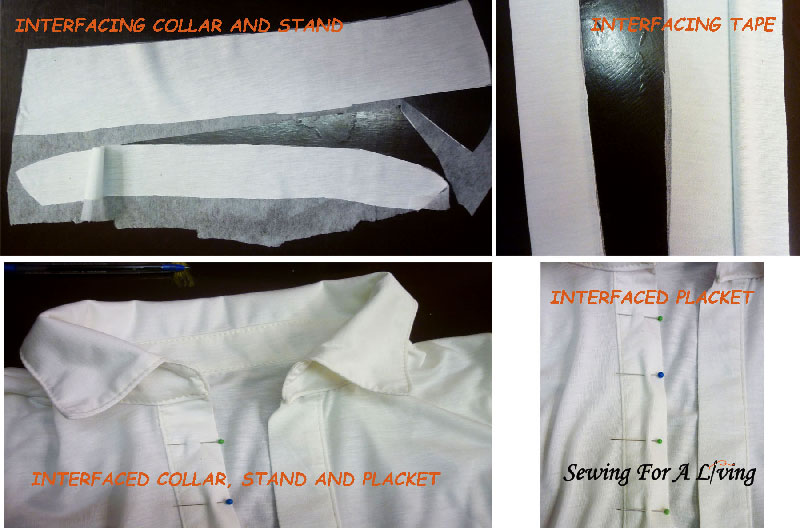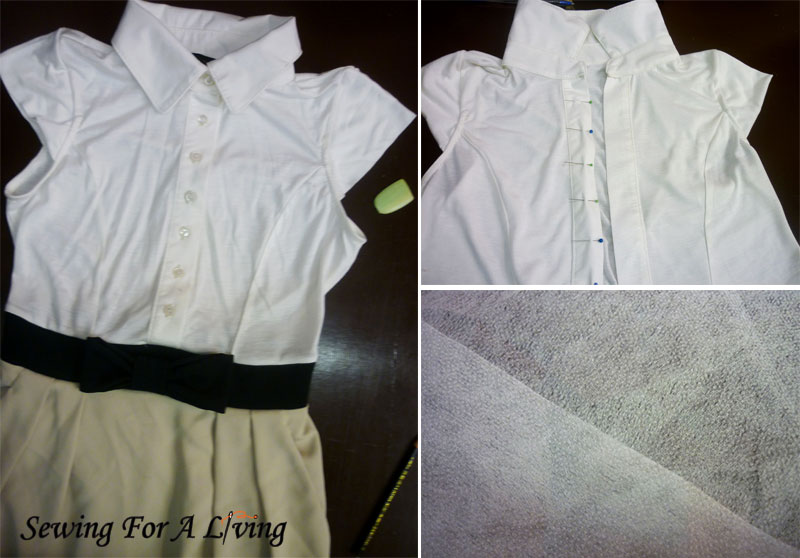What is interfacing in sewing?
Interfacing in sewing relates to adding a layer inside of those parts of the garment that need to be stiffened. You can use it on a collar, plackets, cuffs, etc.
Usually,
there are instructions on the pattern where you should use it. For me, it is the most annoying part of sewing.
But,
it makes all the difference in the appearance and functionality of a garment. That’s why it is a step that you don’t want to skip.

You might’ve noticed that interfaced fabric details look and feel different. For example, it can eliminate stretching where you don’t want it.
Or,
it can add some stiffness to parts of the garment like armholes and neckline.
What types of interfacing are there?
There are different types of interfacing. It differs in the way of attachment, the color, weight, and the material it is made of. For different types of fabric, you need to pick the interfacing that matches the weight, composition, and behavior of that fabric.
Therefore, making the right choice can really influence the result, you are going to get.
Usually, sewing patterns come with a note which is the best type of interfacing for that sewing project.
Also, when you buy interfacing it should come with instructions on how to use it. Those instructions include: should you use steam or not, what temperature to set the iron on, etc.
Here are the most common types of interfacing used in garment sewing that you can pick from.
What is Fusible and Sew-in interfacing
Fusible interfacing is applied with an iron. It has small dots of textile glue on one side and it is smooth on the other.
When it is steamed or heated with the iron, those small dots melt and the interfacing gets glued to the wrong side of the fabric.
Make sure to use a press cloth to prevent the glue from sticking on the iron table or any other pieces of the garment.
Also, be careful not to make wrinkles on the face fabric when applying the interfacing, because they are not going to be removed easily later.
Fusible interfacing can be woven and non-woven. The woven one looks more like fabric. It has a grainline, so make sure to apply it accordingly.
Otherwise,
there might be unwanted consequences like stretching or wrinkles on the face fabric.
The non-woven one looks more like paper and it has a more delicate structure. You can apply it in аny direction. It’s a better match for light to medium-weight fabrics.
There is also a fusible tricot interfacing that looks and feels like a light-weight knit fabric. It stretches and goes well with knit fabrics.

Sew-in interfacing is the one that doesn’t have glue and you need to sew it to the pieces you need to apply it to.
How to attach interfacing?
Sew-in interfacing is attached by sewing it in the seam allowance.
I prefer to use only fusible interfacing in my projects. It adds stiffness to the whole surface of the detail that is attached to while the saw in leaves some space between the fabric and itself.
There are some other types of interfacing on the market like fusible fleece, foam interfacing, and some very hard and thick ones. They make the interfaced fabric very rigid. Those interfacings are more suitable for bag making and crafts and not so much for garment making.
That’s why I am not going to go over them in much detail.
This makes them suitable for upholstery, bags, and purses. For fabrics I typically use (like rayon, cotton jersey, spandex, woven fabrics for apparel), I prefer those three types shown in the picture above.
For more advice on how to work with knits, read this article.
What is the difference between interfacing on the bolt and stay-in tape?
Interfacing is found in many forms and shapes on the market. You may choose to buy it pre-cut, on tapes with different width and color, or on bolts like fabric.
I prefer to use tapes with the appropriate width for slits and cuffs. And fabric-like for collars, stands, and waistbands.
If you don’t sew with interfacing regularly, you can get only interfacing on the bolt and cut it in any form.
As for the color, I’ve only come across white and black interfacing, no matter if it’s woven, nonwoven or tricot. I like to buy the same types in black and use them on darker fabric.

How do you use fusible interfacing and how much?
This is a dress I made from a very lightweight rayon jersey fabric. I prefer to use white non-woven fusible interfacing for a couple of reasons:
- the fabric I used is very light and transparent. Any thicker interfacing would look and feel unnatural to the other parts of the garment;
- this fabric doesn’t have any lycra added, but it stretches a bit. The fusible interfacing eliminates most of the stretching into interfaced details.
How to apply interfacing to the fabric
I used a hot iron. For the collar and the collar stand, I used the interfacing on the bolt.
For the slit, I used a stay-in tape that has the appropriate width.
As a rule, interface just one of the facing details. This way they don’t get too rigid.
I also use a piece of old fabric to prevent the interfacing from sticking to my fabric or the iron board. After the glue dots stick to the wrong side of the fabric, I cut the details out.
Another way is to pre-cut the interfacing in the shape of the detail you want to interface.
In the picture below you can see the result I got from using interfacing. It is much more distinct when the garment is nicely ironed (sadly I didn’t take a picture).

What can I use instead of sewing interfacing?
Not every sewing project requires interfacing, so I would recommend investing a little money into it. Use it instead of any substitutes – it has specific qualities that influence the results you are about to get.
If you don’t have an alternative, you can use some piece of rigid fabric just as you would use a sew-in interfacing.
Where can I buy fusible interfacing?
Usually,
interfacing can be found in any local sewing shop. You can buy it many places online, too.
Do you find this tutorial helpful? Or perhaps you have a question? Don’t hesitate to drop me a line in the comment section below.
Related posts:

Pingback: Interfacing Sewing - Superlabelstore
Thanks for a very good article. Learned a lot.
You are welcome, glad to hear it:)
Good to know! I use pieces of fabric for interfacing and, honestly, I don’t get the best results. I’m working on a pair of pants now, and I am getting more and more frustrated with the waistband. If I use fusible interfacing, will I get better results?
Hi Joan, you sure will. Give it a try and let me now how it is going.
Thanks for this article, I’ve learned a lot!
Great, thank you for your feedback!
Hey there it’s Alexey. It’s actually amazing how well you know the subject. I can honestly learn a lot by only reading your articles. My girlfriend likes to sew and I think that referring her to this site will make her good 🙂 maybe she’ll learn a thing or two!
(just kiddin’ she are going to learn tonne of information).
I hope she is going to find my tutorials helpful. Thank you for your kind words.